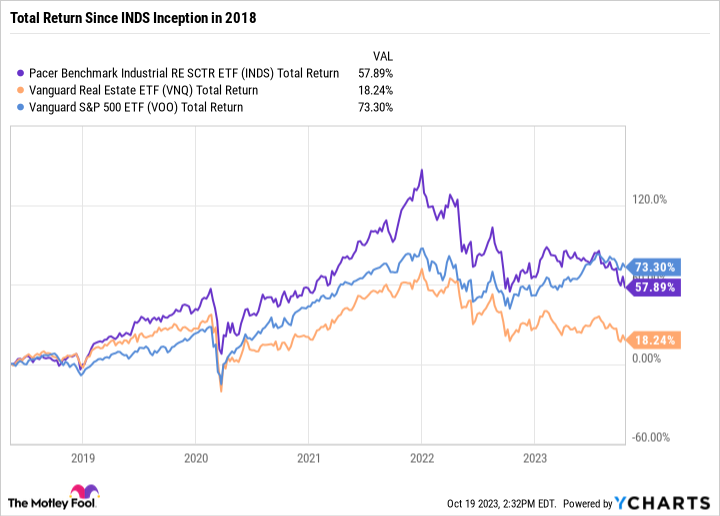Rising interest rates and other headwinds have hammered the commercial real estate market, beating down the share prices of many solid companies that now present a good buying opportunity.
Many of these are real estate investment trusts (REITs), pools of properties that are required by tax law to pay out at least 90% of their taxable income to shareholders as dividends each year. There are more than 200 publicly-traded REITs, renting to tenants in industries ranging from retail to cell towers to farmland and more.
One of the best-performing sectors here has been industrial REITs. This includes owners of both manufacturing and warehouse facilities, and it’s the latter that has really driven this sector’s success, especially since the pandemic drastically changed the dynamics of and demands on the global supply chain, logistics, and e-commerce.
With e-commerce accelerating rapidly, companies rushed to secure logistics and warehouse space to meet customer demands. Manufacturers and retailers added to that demand with their need for just-in-case rather than just-in-time inventory resilience. The result was a bull market for owners of that kind of space.
INDS Total Return Level data by YCharts
What goes up must come down, and back up again
But what goes up must come down, and that’s exactly what happened, as the chart above shows by using three exchange-traded funds (ETFs) as benchmarks. Pacer Industrial Real Estate ETF (INDS -1.06%) is an exchange-traded fund that was launched in May 2018. It tracks the Solactive GPR Industrial Real Estate Index by investing in companies it says are part of the e-commerce distribution and logistics networks along with self-storage facilities.
INDS holds about 30 industrial REITs at any time. Our other two benchmarks here are the Vanguard Real Estate ETF, which holds about 160 REITs of multiple types, and the Vanguard S&P 500 Index Fund ETF.
That drop has been driven by fears of oversupply as huge amounts of new warehouse space come online, along with the rising cost of capital amid surging interest rates. But the long-term demand remains, and the sector still has room to walk, if not run, for years to come.
That’s according to research from Prologis (PLD -0.15%), which, along with being the largest logistics space operator in the world, is the largest holding of the INDS index fund, currently at about 16%.
In a September 2023 report, Prologis analysts cite four global trends that point to continued promise for logistics REITs: 1) rising barriers to continued capacity growth for regulatory and institutional reasons; 2) reaccelerating e-commerce; 3) continued demand for space to counter disruptions with resilience; and 4) contracting new building deliveries that will continue to keep vacancies below historic norms.
Like the stock market has historically done, industrial REITs are likely to recover significantly, especially when interest rates start falling. So, how to choose a single winner or two among so many downtrodden REITs right now? You don’t have to put all your eggs in one basket.
Image source: Getty Images.
Consider a basket approach to investing
Instead, consider a basket approach. In this case, that means investing in a diversified portfolio of industrial REITs, such as that held by the Pacer fund mentioned above.
While there aren’t a lot of ETFs that invest only in industrial REITs, there are plenty that invest in REITs in general, and you can look at their portfolios to see how much presence Prologis and its competitors have in them.
You can also invest in several proven performers to create your own basket, with an eye toward diversification among those companies in the same business.
For instance, Prologis has a global presence, while Rexford Industrial is in southern California and Terreno Realty focuses on small logistics sites in major U.S. coastal markets. Stag Industrial (STAG -1.03%) takes an opposite approach with a collection of logistics properties mostly east of the Mississippi, and you have a geographically diverse grouping of companies.
The Nareit trade group, in fact, lists 11 companies as industrial REITs. But many more are diversified REITs that include such properties in their portfolios, and a significant number of them are actively moving away from particularly troubled businesses, such as owning offices, into industrial properties. Examples include W.P. Carey and Gladstone Commercial.
Short-term fluctuations yield to long-term gain
Whether you make your own basket or buy into one, patience is key. Short-term fluctuations are going to occur, and when good companies are doing badly, that’s a great time to start feathering that nest egg with solid, long-term investments.
This strategy also pays dividends. Successful REITs provide consistent, growing rental income streams. For instance, the Pacer Industrial ETF and the big Vanguard REIT ETF are both yielding nearly 5%, compared with about 1.6% for the Vanguard S&P 500 ETF.
Plus, as the demand for warehouse space continues to grow, rental income from these REITs is likely to remain stable or even increase over time, and that may well result in larger payouts. And you can benefit from these secular trends while mitigating the risk of concentrating on a single equity.
Marc Rapport has positions in Prologis, Terreno Realty, and Vanguard Specialized Funds-Vanguard Real Estate ETF. The Motley Fool has positions in and recommends Prologis, Terreno Realty, Vanguard S&P 500 ETF, and Vanguard Specialized Funds-Vanguard Real Estate ETF. The Motley Fool recommends W. P. Carey. The Motley Fool has a disclosure policy.




